The International Supercomputing Conference 2024 witnessed a landmark achievement – the Aurora supercomputer, a collaborative effort by Intel, Argonne National Laboratory, and Hewlett Packard Enterprise, shattered the exascale barrier.
The Aurora supercomputer didn’t just achieve exascale performance (over 1 quintillion calculations per second) – it became the world’s fastest AI system for open science, reaching a staggering 10.6 AI exaflops.
This isn’t just about raw power; it’s about ushering in a new era of scientific discovery fueled by artificial intelligence.
Significance of Aurora’s Achievement: Why it’s Special?
Aurora’s achievement is a watershed moment. It demonstrates the incredible progress in AI and HPC hardware, pushing the boundaries of what’s possible. But more importantly, it opens doors previously locked.
Imagine delving into the human brain’s intricate network of 80 billion neurons, or using deep learning to unlock the secrets of high-energy particle physics. This is the transformative potential of generative AI models, and Aurora is poised to be a game-changer.
These models can learn from existing data to generate new insights and simulations, accelerating scientific discovery in ways unimaginable before.
Early projects on Aurora demonstrate this power – mapping the human brain, enhancing particle physics research, and even speeding up drug discovery through machine learning. It’s like having a superpowered scientific collaborator, one that can analyze massive datasets and propose entirely new avenues for exploration.
Furthermore, unlike traditional supercomputers, Aurora was designed with AI in mind. This focus on generative AI models – systems that can learn and create new data – is a game-changer. And Aurora has already made significant progress in various fields.
It’s helping map the intricate landscape of the human brain, enhancing our understanding of high-energy physics, and speeding up the drug discovery process through machine learning. This is just the beginning.
As scientists explore the potential of generative AI models on Aurora, we can expect even more groundbreaking discoveries across diverse disciplines.
But how Aurora has become such a powerful supercomputer, let’s dig into its specs.
Aurora’s Technical Specifications You Need to Know

Aurora isn’t just about raw processing power; it’s a marvel of engineering designed specifically for AI workloads. Here’s a breakdown of the key specs that make it tick:
a. Massive Scale: Aurora is a behemoth, boasting 166 racks housing over 10,624 compute blades. Imagine a room filled with servers, that’s essentially Aurora! This sheer scale allows for massively parallel processing, a key ingredient for tackling complex AI problems that involve analyzing enormous datasets.
b. Processing Powerhouse: Each compute blade is equipped with powerful Intel Xeon CPU Max Series processors, ensuring exceptional central processing capabilities. This focus on traditional CPU power alongside the massive GPU array highlights Aurora’s versatility – it can excel at both general-purpose computing and specialized AI workloads.
c. The Muscle of AI: The true stars of the show are the 63,744 Intel Data Center GPU Max Series units. These GPUs are specifically designed for AI and HPC tasks, featuring specialized hardware for complex matrix and vector computations – the kind of calculations that form the foundation of AI algorithms. However, this trade-off might be necessary for certain AI tasks but could lead to higher power consumption.
d. Unified Memory Architecture: Aurora features a unified memory architecture, allowing CPUs and GPUs to seamlessly access the same pool of data. This eliminates bottlenecks that can occur when data needs to be transferred between separate memory spaces.
e. High-Speed Interconnect: Imagine a superhighway connecting Aurora’s components. This ensures efficient data transfer. The use of Ethernet, a mature technology, provides a balance between performance and cost for future large-scale deployments. While it might not offer the absolute highest bandwidths, it provides a balance between performance and cost-effectiveness, which could be crucial for future large-scale deployments of similar systems.
f. Beyond Exascale: While the official announcement focused on breaking the exascale barrier (over 1 exaflop), it’s worth noting that Aurora achieved 1.012 exaflops on the HPL benchmark, utilizing only 87% of its total capacity. This suggests even more processing power can be unlocked in the future.
These specifications paint a picture of a truly impressive machine, custom-built for the demands of AI. It’s a testament to the incredible advancements being made in supercomputing technology.
The Future is Bright: Expanding Capabilities and Next-Gen Tech
The future of scientific discovery is bright. New supercomputers like the Euro-Mediterranean Centre on Climate Change’s Cassandra and the Italian National Agency for New Technologies’ CRESCO 8 are being built using Intel’s latest Xeon and Data Center GPU Max Series technologies.
These systems will tackle some of humanity’s most pressing challenges, from accurately modeling climate change to achieving breakthroughs in fusion energy. The mixed-precision AI benchmark results from Aurora will also inform the design of Intel’s next-generation Falcon Shores GPU, paving the way for even more powerful AI and HPC systems.
Indeed, the Aurora supercomputer is more than just a machine; it’s a symbol of a new era in scientific exploration. By harnessing the power of AI and fostering open collaboration, Aurora is poised to unlock a treasure trove of scientific knowledge, propelling us further into the unknown.
Furthermore, as we delve into the groundbreaking advancements propelled by the Aurora Supercomputer in AI research, it’s impossible to overlook the paradigm-shifting innovations pioneered by SpiNNcloud Systems’ Brain-Inspired Supercomputer.
Just as Aurora pushes the boundaries of AI science with its immense computational power, SpiNNcloud’s brain-inspired architecture revolutionizes neural network simulations, offering a fascinating glimpse into the future of cognitive computing. Discover how these two cutting-edge systems converge to shape the forefront of AI exploration.





